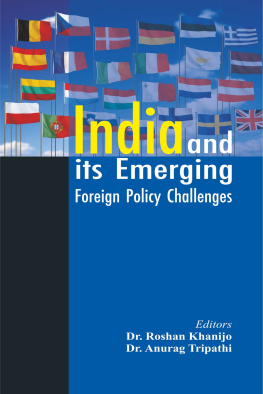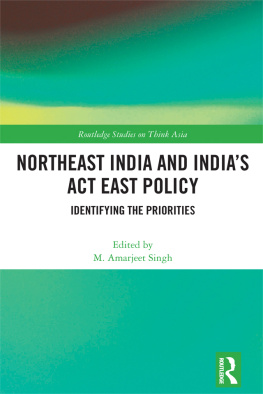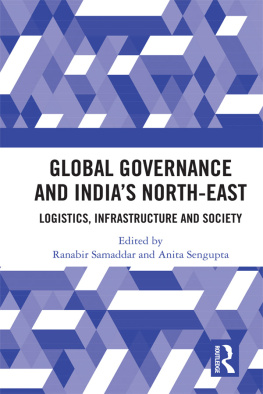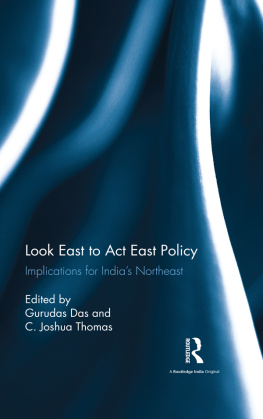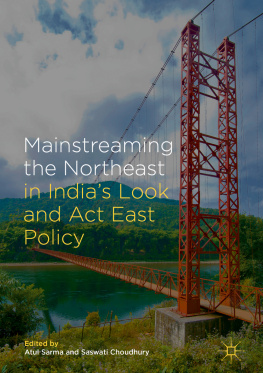
NORTHEAST INDIA AND JAPAN
This book examines the complex and connected past, present, and future of Northeast India and Japan. It looks at the intricate political geography and ethnolinguistic diversity of Indias Northeast, and its historical and strategic relationship between Japan.
From the theatre of the Second World War to a potential economic corridor to the Indo-Pacific, the Northeast, which shares a border with China, Nepal, Bangladesh, Bhutan and Myanmar, has emerged as an area of central importance in IndiaJapan relations. The book highlights the importance of connectivity and cooperation in the North Eastern Region, for sustainable growth, better accessibility, and quality of life. The chapters in the volume look at shared economic, socio-political, and environmental concerns of the two countries as well as the shared legacies between Japan and the Northeast through stories, collective memories and memorials about World War II, and research. They also explore the strategic implications of Chinas One Belt One Road initiative in the region and for IndiaJapan relations, Indias Act-East policy, provincial politics and ethnic conflicts, and the challenges for sustainable development and greater cooperation for the two countries.
With contributions from both Indian and Japanese academics, this book will be a key resource on understanding Asian politics. It will be of great interest to scholars and researchers of politics and international relations, strategic studies, development studies, and Asian studies.
Mayumi Murayama serves as Executive Vice President of Japan External Trade Organization (JETRO) in charge of the Institute of Developing Economies (IDE-JETRO). Her research interests include industry, labour, gender, and youth issues as well as the regional relationship of India and Bangladesh. Some of her publications include Gender and Development: The Japanese Experience in Comparative Perspective, (editor), Globalization, Employment and Mobility: South Asian Experience, (co-edited with Hiroshi Sato), and Borders, Migration and Sub-regional Cooperation in Eastern South Asia, among others.
Sanjoy Hazarika is currently International Director of the Commonwealth Human Rights Initiative (CHRI), New Delhi, which is headquartered in India and has offices in London and Accra. He has designed innovative development interventions such as the boat clinics on the Brahmaputra river and is a columnist in various media and an award-winning former reporter with the New York Times. He is Founder and Managing Trustee of the Centre of North East Studies and Policy Research (C-NES) and established Indias first centre for Northeast studies at a central university at Jamia Milia Islamia. He is a former member of the Justice Jeevan Reddy Committee to review the Armed Forces Special Powers Act (AFSPA) and former member of the National Security Advisory Board. Journalist, researcher, editor, and expert on the Northeast and its neighbourhood, he has made more than a dozen documentaries on the Tsangpo-Brahmaputra river, environmental issues, human rights and conflict. His books include the acclaimed Strangers of the Mist, Tales of War and Peace from Indias North East; Rites of Passage; Writing on the Wall; Bhopal, the Lessons of a Tragedy and, most recently, Strangers No More, published 25 years after the pioneering Strangers of the Mist. His work has appeared in newspapers, journals and magazines across the world, and he has contributed to The Encyclopedia of Global Human Migration and various nonfiction anthologies.
Preeti Gill is an independent literary agent who has more than 20 years of experience in the publishing industry as a commissioning editor and rights director. She has travelled extensively in the Northeast of India and written on issues of conflict and women. She is the editor of T he Peripheral Centre: Voices from Indias Northeast as well as Bearing Witness: A Report on the Impact of Conflict on Women in Nagaland and Assam. Her writing has appeared in numerous journals and anthologies including 1984 in Memory and Imagination (2016).
First published 2022
by Routledge
2 Park Square, Milton Park, Abingdon, Oxon OX14 4RN
and by Routledge
605 Third Avenue, New York, NY 10158
Routledge is an imprint of the Taylor & Francis Group, an informa business
2022 Institute of Developing Economies, Japan External Trade Organization (IDE-JETRO)
The right of Institute of Developing Economies to be identified as the authors of the editorial material, and of the authors for their individual chapters, has been asserted in accordance with sections 77 and 78 of the Copyright, Designs and Patents Act 1988.
All rights reserved. No part of this book may be reprinted or reproduced or utilised in any form or by any electronic, mechanical, or other means, now known or hereafter invented, including photocopying and recording, or in any information storage or retrieval system, without permission in writing from the publishers.
Trademark notice: Product or corporate names may be trademarks or registered trademarks, and are used only for identification and explanation without intent to infringe.
British Library Cataloguing-in-Publication Data
A catalogue record for this book is available from the British Library
Library of Congress Cataloging-in-Publication Data
A catalog record for this book has been requested
ISBN: 978-0-367-53050-1 (hbk)
ISBN: 978-0-367-75991-9 (pbk)
ISBN: 978-1-003-16502-6 (ebk)
DOI: 10.4324/9781003165026
Typeset in Sabon
by Apex CoVantage, LLC
CONTENTS
MAYUMI MURAYAMA
SANJOY HAZARIKA
PART I
Connectivity for the Northeast from an international perspective
1 Connectivity of India and Japans cooperation
TAKENORI HORIMOTO
2 Border and connectivity in Indias North Eastern Region: IndiaChina border and Arunachal Pradesh
MARIE IZUYAMA
PART II
Northeast economy and connectivity
3 Economic and development policies in the North Eastern Region and the current condition
K KOKHO
4 Connectivity and Northeast India: challenges and ways forward
PRABIR DE
5 Economic potentials of road infrastructure developments in and around the North Eastern Region
SATORU KUMAGAI AND KENMEI TSUBOTA
PART III
Northeast and connectivity from peoples perspective
6 Provincial politics and the Act East Policy: how political dynamics within Northeast India influences connectivity
SAMRAT CHOUDHURY
7 Connectivity in a disconnected society: territorialism and exclusive citizenship in Indias Northeast
HIROSHI SATO
8 Ethnic conflicts and local autocracy in Indias North Eastern Region: a case study of ethnic clashes in Bodoland, Assam, in 2012 and 2014
MAKIKO KIMURA
9 Connectivity in Northeast India: women, violence, womens writing
PREETI GILL
PART IV
Northeast and Japan from the past to the present
10 Partitioned lives: Myanmar-born Indians in the Manipur borderland
NORIYUKI OSADA
11 Northeast India, World War II and Japan: past, present and future
YAIPHABA MEETEI KANGJAM AND HEMANT SINGH KATOCH
12 Mutual perspectives of people of Japan and Northeast India during World War II
MAYUMI MURAYAMA




